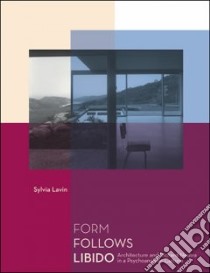Form Follows Libido - 9780262622134
Un libro in lingua di Sylvia Lavin edito da Mit Pr, 2007
- € 22.30
- Il prezzo è variabile in funzione del cambio della valuta d’origine
"Eight million Americans a year cool their heels in psychiatric waiting rooms. Design can help lower this nervous overhead."-- Richard Neutra, 1954Sylvia Lavin's Form Follows Libido argues that by the 1950s, some architects felt an urge to steer the cool abstraction of high modernism away from a neutral formalism toward the production of more erotic, affective environments. Lavin turns to the architecture of Richard Neutra (1892-1970) to explore the genesis of these new mood-inducing environments. In a series of engaging essays weaving through the designs and writings of this Vienna-born, California-based architect, Lavin discovers in Neutra a sustained and poignant psychoanalytic reflection set in the context of a burgeoning psychoanalytic culture in America.Lavin shows that Neutra's redirection of modernism constituted not a lyrical regression to sentimentality but a deliberate advance of architectural theory and technique to engage the unconscious mind, fueled by the ideas of psychoanalysis that were being rapidly disseminated at the time. In Neutra's responses to a vivid range of issues, from psychoanalysis proper to the popular psychology of tele-evangelical prayer, Lavin uncovers a radical reconstitution of the architectural discipline.Arguing persuasively that the received historical views of both psychoanalysis and architecture have led to a suppression of their compelling coincidences and unorthodoxies, Lavin sets out to unleash midcentury architecture's hidden libido. Neither Neutra nor psychoanalysis emerges unscathed from her investigation of how architecture came to be saturated by the intrigues of affect, often against its will. If Reyner Banham sought to put architecture "on the couch," then Lavin, through Neutra, leaps beyond Banham's ameliorative aim to lure contemporary architecture into the lush and dangerous liaisons of environmental design.
Informazioni bibliografiche
- Titolo del Libro in lingua: Form Follows Libido
- Sottotitolo: Architecture and Richard Neutra in a Psychoanalytic Culture
- Lingua: English
- Autore: Sylvia Lavin
- Editore: Mit Pr
- Collana: Mit Pr (Paperback)
- Data di Pubblicazione: 31 Ottobre '07
- Genere: ARCHITECTURE
- Argomenti : Architects Psychology Modern movement (Architecture
- Pagine: 182
- Dimensioni mm: 266 x 215 x 19
- ISBN-10: 0262622130
- EAN-13: 9780262622134


